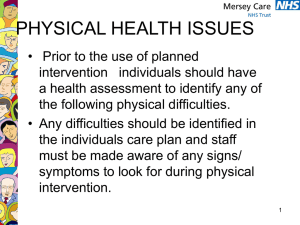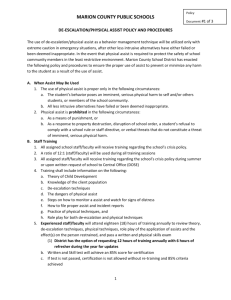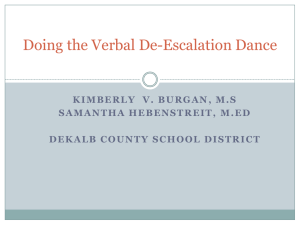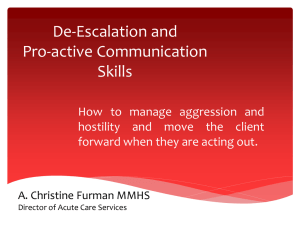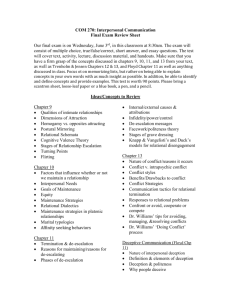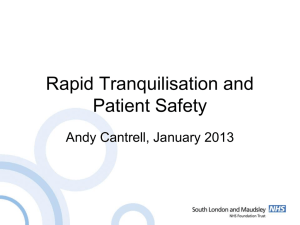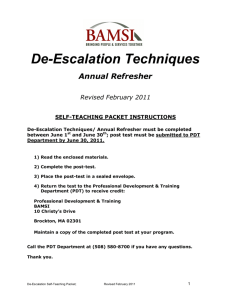Module 6 – De-escalation
advertisement
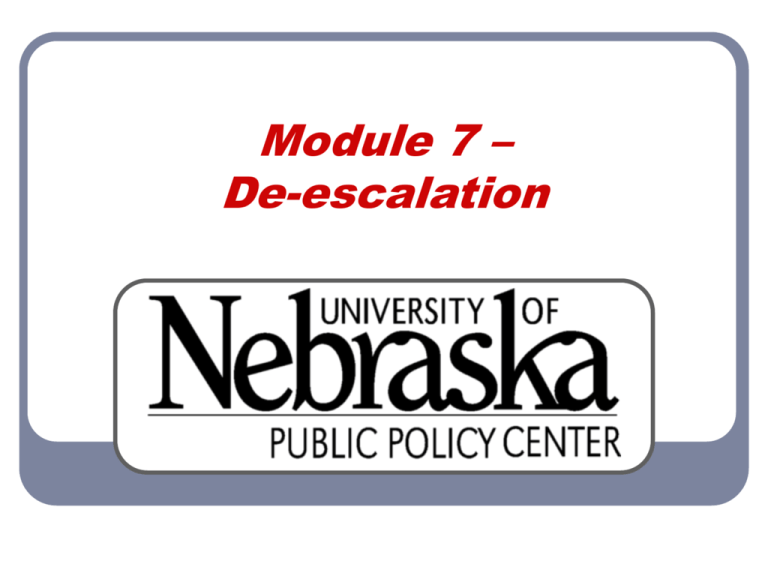
Module 7 – De-escalation Learning Objectives Demonstrate communication skills that can be used to calm anxious or agitated individuals Understand common signs of escalating anxiety Identify effective methods of de-escalating anxious or agitated behavior Module 6 De-escalation 2 Intense Emotions Are often appropriate reactions following a disaster Can often be managed by community responders Module 6 De-escalation 3 Anxiety A state of intense apprehension, uncertainty and fear Results from anticipating a threatening event Intense anxiety = “fight or flight” Module 6 De-escalation 4 Phases of Disaster Heroic Phase Honeymoon Phase Disillusionment Phase • May last from two months to several years. • Strong feelings of anger and resentment can be directed at volunteers and other public officials. Reconstruction Phase Module 6 De-escalation 5 Communication and Empathy Skills L-Shaped Stance: • Demonstrates respect • Decreases confrontation Module 6 De-escalation 6 Activity 18 Person A will stand with their shoulders at right angles to the shoulders of Person B. Module 6 De-escalation 7 Warmth SOLER oSit squarely oOpen Posture oLean Forward oEye Contact oRelax Module 6 De-escalation 8 Warmth Soft tone Smile Interested facial expression Open/welcoming gestures Allow the person you are talking with to dictate the spatial distance between you (This can vary according to cultural or personal differences) Module 6 De-escalation 9 Activity # 19 - Warmth Pick a partner. Turn to your partner and say: • "My garbage pick up is on Tuesdays.” • Practice looking warm while saying this. • Give feedback to each other as to what they could do from the previous list to make this interaction seem warmer. Module 6 De-escalation 10 Door-openers • Then what happened? • Then what did you do? • That is really interesting. • Wow, then what? • I see … • How did you handle that? • What helped you in that situation? • Tell me more (about that)… Module 6 De-escalation 11 Non-verbal Communication SOLER (Sit squarely, Open Posture, Lean Forward, Eye Contact, Relax) Head nodding Close proximity with the L-shaped stance Avoid impersonal or "cold" stares Focus on the speaker, not on the paperwork Appropriate facial expressions (e.g. smiling, expressions of warmth and acceptance, etc.) Module 6 De-escalation 12 Activity # 20 – Door Openers Break up into pairs. • • One person must initiate and continue a conversation using door-openers. The second person must not make it easy for them, however, remember that this is practice, don't make it overly difficult for your partner. Spend 5 minutes doing this, and when the signal for "time up" is given, switch and let the other person practice using door-openers. Module 6 De-escalation 13 Open-ended v. Closed-ended Questions Open-ended questions • Allow people to talk more freely Close-ended questions • May help “jump start” the individual who is • • having trouble talking at all Helps focus the person who is very upset or talking too much Are easier for an anxious person to mentally process Module 6 De-escalation 14 Activity # 21- Open-ended Questions Convert following closed-ended questions to open-ended questions. • • • • • • • Have you eaten today? Did you apply for assistance with FEMA? Were you scared when you heard the sirens? How many children do you have? Are they treating you all right in the shelter? Where was your house? Do you have anyone to support you while you go through this? Module 6 De-escalation 15 Para-verbal Communication Refers to : • Voice Tone • Volume • Rate of speech. Para-verbal communication is how we say something, not what we say Module 6 De-escalation 16 Para-verbal Communication One sentence can convey entirely different meanings depending on the emphasis on words and the tone of voice. I didn’t tell George you were incompetent. Module 6 De-escalation 17 Congruence Matching words and actions Incongruence • Denotes trustworthiness • Shows others that we care • Shows we are in control • Interpreted as being untrustworthy or inauthentic Module 6 De-escalation 18 Active Listening Emphasizes that we are attending Improves communication Shows empathy Reflects what the other person is saying Does NOT offer advice Module 6 De-escalation 19 Active Listening Structure Attend to the speaker completely Repeat, in your own words (paraphrase) what you heard the speaker say • Does NOT mean you agree with what they said. Speaker then gives feedback to the listener as to whether what they heard was accurate. Module 6 De-escalation 20 Active Listening Tips Read the non-verbal as well as the verbal communication to assess feelings Check back with the person about their feelings as well as the content If you're not sure how the person feels, ask about it e.g. "How do you feel about that?" "How did that affect you?" Don't ignore or deny the speaker’s feelings Don’t tell people how they should feel or think Module 6 De-escalation 21 Active Listening Tips Reflect back what you hear the person say so they can hear it themselves and know you understand If you get it wrong, ask an open-ended question and try again e.g. "How do you see the situation?" If appropriate, direct the conversation back to the point Allow silences in the conversation Module 6 De-escalation 22 Active Listening Tips Avoid phrases like “Can you tell me…” or “Would you tell me…” – These types of phrases can be answered “no” and often makes your job harder. Be careful with “Why questions” – These questions can often sound judgmental. Ask one question at a time and avoid double questions (e.g. Were you feeling tired or were you just trying to get out of the situation?). Module 6 De-escalation 23 Paraphrase/Reflection Assures the person who is talking that you are listening and have accurately heard the central meaning of their message Clarifies the content of the topic Helps keep others on topic rather than going off on tangents Module 6 De-escalation 24 Paraphrase/Reflection of Content Simply rephrases, rewords, and reflects what the other person just said. For example: Speaker: “Yesterday, it was just so hard to get up and get going. I just sat around the house. I had errands to run, but I couldn’t seem to make myself get up and do them” Listener using Simple Reflection: “It sounds like you had a lot of trouble getting up and going” Module 6 De-escalation 25 Paraphrase/Reflection of Feelings Lets the person know that you heard their expression of emotions. This can enhance the sense of being understood and may encourage further emotional expression. For example: Speaker: “I’m so scared and I don’t know what I’m going to do next. My house is gone…everything is gone” Listener using Reflection of Feelings: “You seem afraid and uncertain.” Speaker: “Yes! I’m just so frightened and I don’t know what’s going to happen next.” Module 6 De-escalation 26 Activity # 22 – Paraphrase Practice Paraphrase the following statements with an emphasis on the emotions: 1.My back is killing me, I haven't had a day off in weeks, and I am sick and tired of working all the time! 2.I don't know who she thinks she is! Just because her family has money, doesn’t mean she should be the first one in line! Module 6 De-escalation 27 Activity 22 (cont.) 3. I don't know what's wrong with me. I can't seem to get organized. I keep thinking about what happened. I just can't believe it. 4. I don't have anyone to help me. I don't know how I'm supposed to do all of this on my own now. 5. I can't do this job anymore. I've seen too much. This was not supposed to happen. Module 6 De-escalation 28 Benefits of Active Listening Shows empathy Builds relationships Helps people acknowledge their emotions and to talk about them instead of negatively acting on them Clears up misunderstandings between people Module 6 De-escalation 29 Cultural Conflicts 1. There are usually expectations about one's own and others' behavior 2. Strong emotions are present, even when the reason for the disagreement is small Module 6 De-escalation 30 Resolving Cultural Conflicts 1. 2. 3. 4. 5. Be aware that culture may be a factor. Be willing to work on the cultural issues. Be willing to talk about how the other person's culture would address this problem. Develop a solution together. If there is confusion or a misunderstanding…talk about it and learn from each other. Module 6 De-escalation 31 Activity # 23 – Active Listening Divide into groups of three: Speaker • You have just lost your home to a tornado. You are trying to find out what assistance you qualify for, since you had no insurance. Listener • Use the skills discussed in this module. See the list for the Observer. Observer • Concentrate on the person in the listener role. Look for: Active listening Door openers, Paraphrasing, Open-ended questions, Non-verbal skills Module 6 De-escalation 32 Agitation Sometimes, despite our best attempts at active listening, people become agitated It is usually not personal This is their reaction to an extremely abnormal situation, and it has nothing to do with you Module 6 De-escalation 33 The Energy Curve Module 6 De-escalation 34 Adrenaline, Friend or Foe? Increase in speed and strength Decrease in reaction time Increase in sensory acuity Freezing and unable to react Overreacting May act in a way that seems inappropriate for the situation (e.g. giggle, yell) Module 6 De-escalation 35 Elements of Escalation Challenging authority or questioning Refusal to follow directions Loss of control, becoming verbally agitated Becoming threatening Module 6 De-escalation 36 Elements of Escalation Challenging Authority or Questioning • Answer the question • Repeat your request in a neutral tone of voice Remember that an ounce of prevention is worth a pound of cure Module 6 De-escalation 37 Elements of Escalation Not Following Directions • Do not take control, • • • help the individual gain control of him/herself Remain professional Consider restructuring your request Give the person time to think about your request Module 6 De-escalation 38 Seek Assistance Loss of Control, Becoming Verbally Threatening • Verbal Vomit If the person becomes threatening or intimidating and does not respond to your attempts to calm them, seek immediate assistance Module 6 De-escalation 39 Elements of De-escalation 1. • • • • Establish a relationship Introduce yourself if they do not know you Ask the person what they would like to be called Don't shorten their name or use their first name without their permission With some cultures, it is important to always address them as "Mr." or "Mrs.", especially if they are older than you Module 6 De-escalation 40 Elements of De-escalation 2. Use concrete questions to help the person focus • Use closed ended questions • If the person is not too agitated, briefly explain why you are asking the question • For example: I'd like to get some basic information from you so that I can help you better. Where do you live? Module 6 De-escalation 41 Elements of De-escalation 3.Come to an agreement on something • Establishing a point of agreement will help • • solidify your relationship and help gain their trust Positive language has more influence than negative language Active listening will assist you in finding a point of agreement Module 6 De-escalation 42 Elements of De-escalation 4.Speak to the person with respect This is communicated with: • Words • Para-verbal Communication • Non-verbal behavior • Use of words like please and thank you Module 6 De-escalation 43 Elements of De-escalation 5.Don't make global statements about the person's character 6.Use “I” statements 7.Lavish praise is not believable Module 6 De-escalation 44 Activity # 24 – Observation of De-escalation One of the instructors will play an agitated individual and the other will play a community responder. Observe closely to see what de-escalation skills the community responder is using to help calm the agitated individual. What did you observe? Module 6 De-escalation 45 Practice Practicing skills allows you to use them in a crisis instead of freezing You must look and act calm even if you are not Module 6 De-escalation 46
